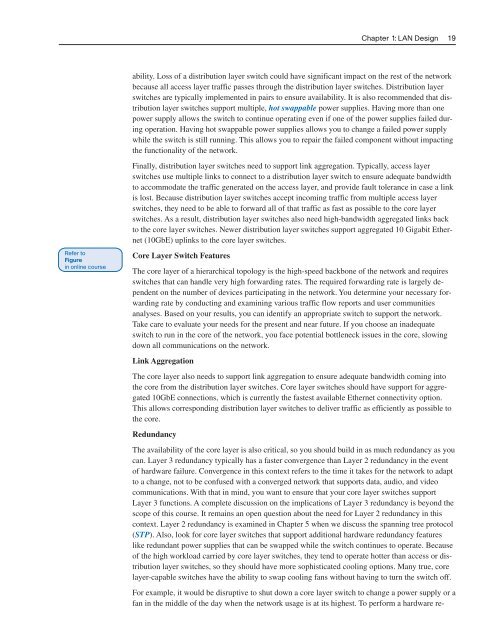CCNA Exploration LAN Switching and Wireless
CCNA Exploration LAN Switching and Wireless
CCNA Exploration LAN Switching and Wireless
Create successful ePaper yourself
Turn your PDF publications into a flip-book with our unique Google optimized e-Paper software.
Chapter 1: <strong>LAN</strong> Design 19<br />
ability. Loss of a distribution layer switch could have significant impact on the rest of the network<br />
because all access layer traffic passes through the distribution layer switches. Distribution layer<br />
switches are typically implemented in pairs to ensure availability. It is also recommended that distribution<br />
layer switches support multiple, hot swappable power supplies. Having more than one<br />
power supply allows the switch to continue operating even if one of the power supplies failed during<br />
operation. Having hot swappable power supplies allows you to change a failed power supply<br />
while the switch is still running. This allows you to repair the failed component without impacting<br />
the functionality of the network.<br />
Finally, distribution layer switches need to support link aggregation. Typically, access layer<br />
switches use multiple links to connect to a distribution layer switch to ensure adequate b<strong>and</strong>width<br />
to accommodate the traffic generated on the access layer, <strong>and</strong> provide fault tolerance in case a link<br />
is lost. Because distribution layer switches accept incoming traffic from multiple access layer<br />
switches, they need to be able to forward all of that traffic as fast as possible to the core layer<br />
switches. As a result, distribution layer switches also need high-b<strong>and</strong>width aggregated links back<br />
to the core layer switches. Newer distribution layer switches support aggregated 10 Gigabit Ethernet<br />
(10GbE) uplinks to the core layer switches.<br />
Core Layer Switch Features<br />
The core layer of a hierarchical topology is the high-speed backbone of the network <strong>and</strong> requires<br />
switches that can h<strong>and</strong>le very high forwarding rates. The required forwarding rate is largely dependent<br />
on the number of devices participating in the network. You determine your necessary forwarding<br />
rate by conducting <strong>and</strong> examining various traffic flow reports <strong>and</strong> user communities<br />
analyses. Based on your results, you can identify an appropriate switch to support the network.<br />
Take care to evaluate your needs for the present <strong>and</strong> near future. If you choose an inadequate<br />
switch to run in the core of the network, you face potential bottleneck issues in the core, slowing<br />
down all communications on the network.<br />
Link Aggregation<br />
The core layer also needs to support link aggregation to ensure adequate b<strong>and</strong>width coming into<br />
the core from the distribution layer switches. Core layer switches should have support for aggregated<br />
10GbE connections, which is currently the fastest available Ethernet connectivity option.<br />
This allows corresponding distribution layer switches to deliver traffic as efficiently as possible to<br />
the core.<br />
Redundancy<br />
The availability of the core layer is also critical, so you should build in as much redundancy as you<br />
can. Layer 3 redundancy typically has a faster convergence than Layer 2 redundancy in the event<br />
of hardware failure. Convergence in this context refers to the time it takes for the network to adapt<br />
to a change, not to be confused with a converged network that supports data, audio, <strong>and</strong> video<br />
communications. With that in mind, you want to ensure that your core layer switches support<br />
Layer 3 functions. A complete discussion on the implications of Layer 3 redundancy is beyond the<br />
scope of this course. It remains an open question about the need for Layer 2 redundancy in this<br />
context. Layer 2 redundancy is examined in Chapter 5 when we discuss the spanning tree protocol<br />
(STP). Also, look for core layer switches that support additional hardware redundancy features<br />
like redundant power supplies that can be swapped while the switch continues to operate. Because<br />
of the high workload carried by core layer switches, they tend to operate hotter than access or distribution<br />
layer switches, so they should have more sophisticated cooling options. Many true, core<br />
layer-capable switches have the ability to swap cooling fans without having to turn the switch off.<br />
For example, it would be disruptive to shut down a core layer switch to change a power supply or a<br />
fan in the middle of the day when the network usage is at its highest. To perform a hardware re-

















